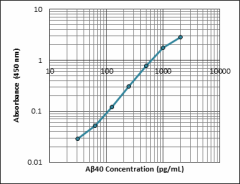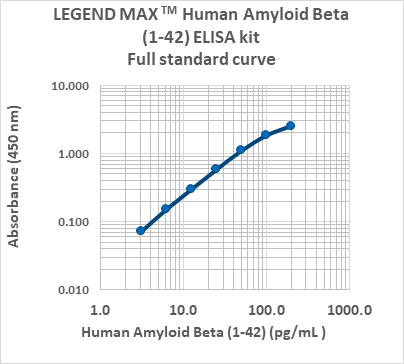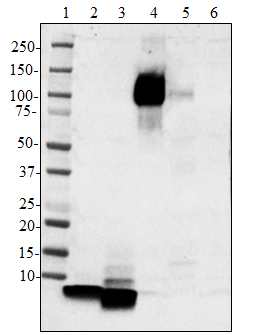- Regulatory Status
- RUO
- Other Names
- AAA, ABETA, ABPP, AD1, APPI, CTFgamma, CVAP, PN-II, PN2, Amyloid beta A4 protein, preA4, protease nexin-II, peptidase nexin-II, beta-amyloid peptide, alzheimer disease amyloid protein, cerebral vascular amyloid peptide, APP, Amyloid precursor protein
- Ave. Rating
- Submit a Review
- Product Citations
- publications

Human amyloid beta (1-40) is a peptide fragment implicated in the onset and progression of Alzheimer’s disease, due to its presence in amyloid plaques that are a hallmark of the disease. This peptide, along with amyloid beta (1-42) and other amyloid isoforms, is generated from the cleavage of amyloid precursor protein (APP). Amyloid beta (1-40) and amyloid beta (1-42) are the two most common isoforms in the brain. While amyloid beta (1-40) is more prevalent, amyloid beta (1-42) is the major component of amyloid plaques. Nevertheless, amyloid beta (1-40) is relevant for Alzheimer’s research because the amyloid beta (1-42)/amyloid beta (1-40) ratio is an important diagnostic for the severity of Alzheimer’s disease.
The BioLegend LEGEND MAX™ Human Amyloid Beta (1-40) ELISA Kit is a Sandwich Enzyme-Linked Immunosorbent Assay (ELISA) with a 96-well strip plate that is pre-coated with a mouse monoclonal anti-human amyloid beta (1-40) antibody. The detection antibody is a biotinylated mouse monoclonal anti-human amyloid beta (1-40) antibody. This kit is specifically designed for the accurate quantitation of human amyloid beta (1-40) in cerebrospinal fluid, serum, plasma, and other biological fluids. This kit is analytically validated with ready-to-use reagents.
Kit Contents
- Kit Contents
-
- Human Amyloid Beta (1-40) Pre-coated 96-well Strip Microplate
- Human Amyloid Beta (1-40) Detection Antibody (200X)
- Human Amyloid Beta (1-40) Lyophilized Standard
- Streptavidin-Polymer HRP
- Assay Buffer E
- Assay Buffer B
- Wash Buffer (20X)
- Substrate Solution D
- Stop Solution
- Plate Sealers
Product Details
- Verified Reactivity
- Human
- Application
-
ELISA
- Sensitivity
- 20.4 ± 6.5 pg/mL
- Standard Range
- 31.25 – 2000 pg/mL
- Materials Not Included
-
- Microplate reader able to measure absorbance at 450 nm
- Adjustable pipettes to measure volumes ranging from 1 µL to 1,000 µL
- Deionized water
- Wash bottle or automated microplate washer
- Log-Log graph paper or software for data analysis
- Tubes to prepare standard dilutions
- Timer
- Polypropylene vials
Antigen Details
- Cell Type
- Neural Stem Cells, Neurons
- Biology Area
- Cell Death, Neurodegeneration, Neuroscience, Neuroscience Cell Markers, Protein Misfolding and Aggregation
- Molecular Family
- APP/β-Amyloid, APP/Aβ Degradation
- Gene ID
- NA
- UniProt
- View information about Amyloid Beta 1-40 on UniProt.org
Related FAQs
- In your LEGEND MAX™ ELISA Kits, there is a step that calls for washing the plates before adding sample. What is the purpose of this step?
-
We typically use a stabilizer for pre-coated plates. The additional washing step is designed to remove these components before you start the assay. If you do not perform the washing, the effect on assay performance is negligible.
- I have multiple LEGEND MAX™ ELISA kits that I want to run simultaneously. Can I use the same wash buffer for all the kits?
-
The wash buffer provided in all our LEGEND MAX™ kits is the same and the part numbers on the wash buffer bottles in these kits should be identical. For ELISA MAX™ Deluxe and ELISA MAX™ Standard Sets, we provide a recipe for the wash buffer on each kit’s technical data sheet. This recipe is the same for all ELISA MAX™ sets.
- For some of your ELISA kits, why do my serum samples require dilution with assay buffer?
-
In some cases, dilution with assay buffer is required to minimize the matrix difference between the samples and the standards to achieve better accuracy.













Follow Us